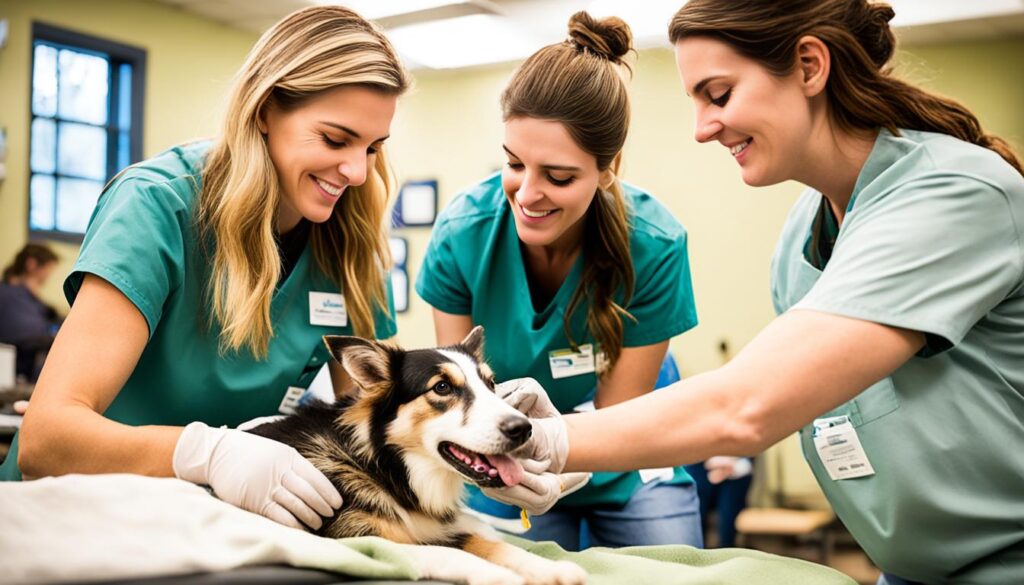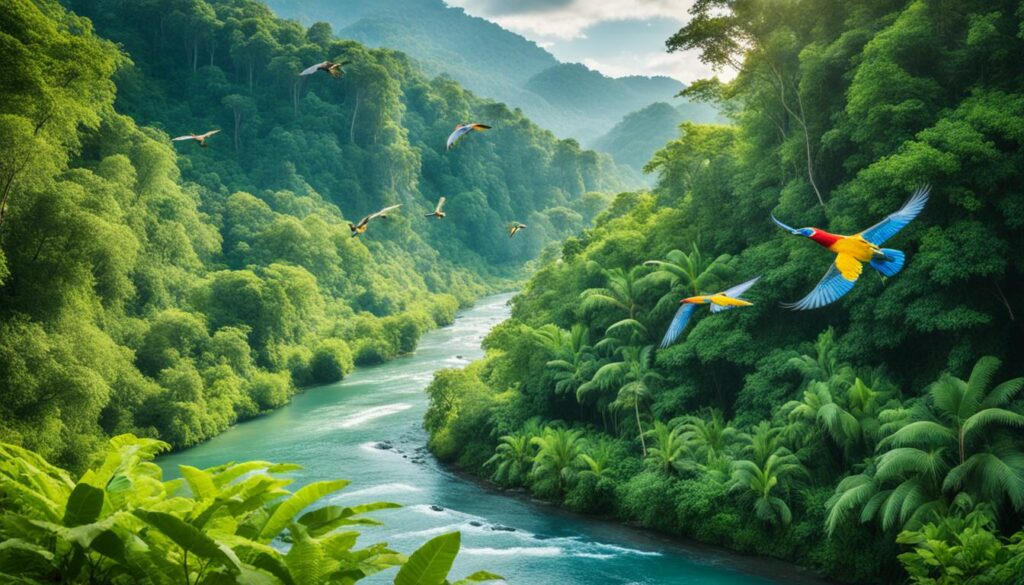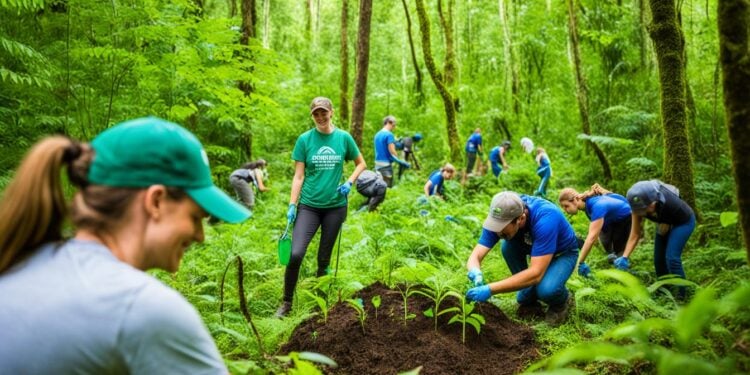Many people care deeply about protecting our planet’s wildlife and their homes. If you want to help animals, volunteering for wildlife conservation is a great way to make a difference. This guide will show you how to help animals and protect the environment through various activities.
You can help with everything from rehabilitating animals to teaching others about nature. Whether you love endangered species, cleaning up the environment, or promoting eco-friendly tourism, there’s a place for you. Volunteering lets you support important projects and connect with nature. Let’s find out how you can help protect our planet’s diverse life.
Discover the Joy of Volunteering for Animal Protection
Volunteering for animal welfare and wildlife conservation is rewarding. It lets you help protect animals and their homes. By volunteering, you can make a real difference in the environment and help animals thrive.
Why Wildlife Conservation Matters
Threats like habitat loss, poaching, and climate change are big problems. They threaten many animal species and our natural world. Volunteering for wildlife conservation helps protect endangered animals, restore their homes, and spread the word about caring for our planet.
The Benefits of Volunteering
Volunteering for conservation volunteering helps animals and the environment. It also has personal benefits. You’ll learn new skills, meet people who share your values, and feel good about making a difference.
Volunteering leads to personal growth and connects you with your community. It makes you a strong supporter of the causes you believe in.
Explore Local Organizations and Their Initiatives
Local organizations are key in wildlife conservation. They know the environmental challenges and wildlife needs in your area. This makes them a great resource for those wanting to help.
Joining local wildlife groups is a good way to find volunteer work that fits your skills. You can help with things like cleaning up habitats, watching over species, or teaching the public. Volunteers are crucial to these groups’ success.
Look into the local wildlife organizations in your area. Many have websites or social media that show their conservation projects and volunteer opportunities. This helps you find projects that matter to your community and how you can help.
Working with these groups means you’re part of community involvement in wildlife conservation. You’ll meet people who care about nature just like you. It’s a fulfilling way to help your local ecosystem.
Animal Rehabilitation Centers: A Hands-On Experience
Animal rehabilitation centers are perfect for those who love animal care and want to help wildlife. These places take in injured, orphaned, or lost animals. Their goal is to make them healthy again and release them back into the wild.
Caring for Injured or Orphaned Wildlife
Volunteering at these centers lets you help with the daily care of the animals. You might feed them, clean their homes, give medicine, and help them recover. It’s a great way to learn about different animals and how to care for them.

Contributing to Release and Reintroduction Programs
Volunteers also help with programs that release animals back into the wild. This includes fixing their homes, watching their progress, and getting them ready to live on their own. Your help is key to helping animals thrive in their natural habitats.
Working at an animal rehabilitation center is very rewarding. You get to make a real difference in the lives of animals and learn a lot about nature. Whether you like caring for animals or want to help the environment, these centers are a great place to be involved.
Join Environmental Cleanup Efforts
Volunteering for environmental cleanup is key to helping wildlife. By removing litter from beaches, forests, and other areas, you help protect vital habitats. These efforts make a big difference in keeping our natural world safe.
Protect Natural Habitats
Joining beach cleanups and litter removal is a hands-on way to help habitat restoration. Your work makes these places beautiful and safe for wildlife. Whether it’s cleaning beaches or removing invasive plants, your efforts are crucial.
You can also help with environmental stewardship in places like rivers, parks, and forests. By removing litter, you protect the homes of many plants and animals. Your work as a conservation volunteer really helps keep nature safe.
Assist with Research and Data Collection
Become a citizen scientist and help with wildlife research and data collection. You can monitor animal populations, track species, and record environmental changes. Your help in citizen science projects gives scientists and conservationists important data. This data helps them make better decisions for conservation monitoring.
Citizen Science Projects
Join volunteer research projects to help wildlife conservation. You can track animals, note changes in plants, and more. Your data is key for researchers and policymakers. These projects let you connect with nature and make a real difference.
If you love nature or just want to learn more, check out citizen science projects near you. By giving your time and observations, you’ll learn about local wildlife and help protect it for the future.
Spread Awareness and Educate Communities
As a wildlife conservation volunteer, you can make a big difference. By joining in on educational events, school programs, or public campaigns, you share important info. This includes facts about endangered species, protecting their homes, and caring for the environment. Sharing this knowledge helps people understand and value nature more.
Your volunteer work can take many shapes. You might talk to students about wildlife challenges and how people can help. Or, you could lead clean-up events to show how trash harms nature. Even simple actions like talking at a farmers’ market can spread the word about protecting the environment.
These efforts help connect science with the public’s understanding. By making complex issues easy to grasp, you encourage people to protect nature. Whether it’s a nature walk, a movie night, or a hands-on activity, your work can deeply impact others.
Wildlife conservation needs people like you to act together. By focusing on spreading the word and helping your community, you’re doing more than just helping locally. You’re part of a worldwide push for caring for our planet and living sustainably.
Participate in Animal Monitoring and Tracking
As a wildlife conservation volunteer, you can help with important animal monitoring and tracking. These activities give valuable insights for research and conservation. By watching and recording animal behaviors, you help researchers understand what different species need.
Understanding Animal Behavior and Movements
Volunteers learn a lot about animal behaviors and movements through monitoring and tracking. You might track birds, watch nocturnal mammals, or study primates. This work shows us how animals live in the wild. The data you gather helps protect endangered species and their homes.
Working on animal monitoring lets you team up with experts. You’ll learn a lot from them and improve your skills. This not only helps conservation efforts but also connects you deeply with nature.
Volunteer at Animal Sanctuaries and Reserves
Animal sanctuaries and wildlife reserves are great places for those who love animal care and protecting their homes. Volunteering here lets you help animals that are rescued, lost, or in danger. You support their recovery and protection.
Providing Care and Enrichment
At these places, volunteers help with important tasks for the animals’ health. This includes feeding, cleaning, and giving them activities that mimic their natural life. These activities keep them happy and healthy.
Your work can really change an animal’s life. You help them get the care they need. This can lead to their recovery and a chance to live in the wild or stay in a safe place.
Volunteering can mean helping injured animals, being part of release programs, or just spending time with them. It’s a rewarding and learning experience. You’ll understand the challenges these animals face and why saving their homes is key.
Volunteering at these places is a great way to help animals and support important conservation work. It’s a fulfilling experience that connects you with nature. You’ll be part of efforts to protect our planet’s amazing wildlife.
Support Sustainable Ecotourism Initiatives
As a wildlife enthusiast, you can make a big difference by supporting sustainable ecotourism. This type of travel focuses on protecting nature and helping local communities. It’s key for keeping wildlife safe.
By volunteering with groups that support sustainable ecotourism, you help create programs that protect nature and support local economies. Your help can grow this industry. This means more jobs and better lives for people and animals.

You can help plan and promote ecotourism activities or work with local communities. Understanding their needs and concerns is important. Your efforts can really change things. By volunteering, you protect wildlife, help communities, and make travel better for everyone.
Look into different volunteer chances in sustainable ecotourism. See how you can be part of a future where protecting wildlife, engaging with communities, and responsible travel come together.
Skills and Qualifications for Wildlife Volunteering
If you love wildlife conservation and want to help, it’s key to know what skills and qualifications you need. The requirements vary by organization and task. You might need physical fitness, technical skills, or a certain education.
Many groups offer training for volunteers. These programs teach about animal behavior, fixing habitats, collecting data, and reaching out to communities. This training helps volunteers learn what they need to do their jobs well.
Experience and language skills can affect who can volunteer. Some jobs are for beginners, while others need more experience or special knowledge. Being able to speak the local language can also help, especially if you’re working with groups from other countries or in diverse places.
The skills and qualifications for wildlife volunteering are varied. By knowing what you need and being open to learning, people from different backgrounds can find ways to help the environment.
Planning Your Volunteer Experience
Starting your wildlife conservation volunteer journey requires careful planning. Look into different organizations that match your interests and fit your schedule. Think about the time you can give, how you’ll get there, and any training you might need.
Learn about the steps to apply for your volunteer role. Be excited to start making a difference in animal protection and their homes. Look for conservation projects that fit your skills and time, making your volunteer work meaningful.
Think about the travel and time needed for your volunteer work. Whether it’s close to home or far away, plan well to use your time wisely. The application process can be different, so be ready to share important details and follow the steps to get your spot.







